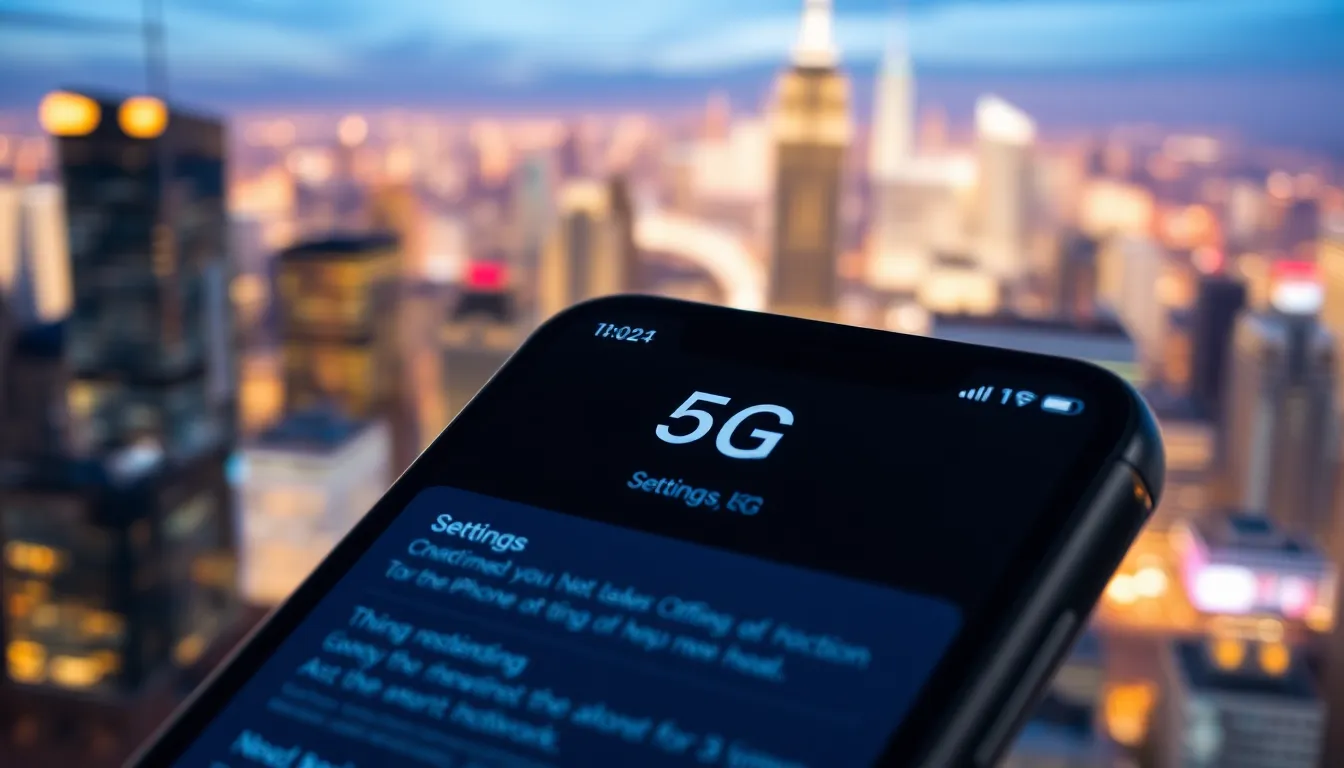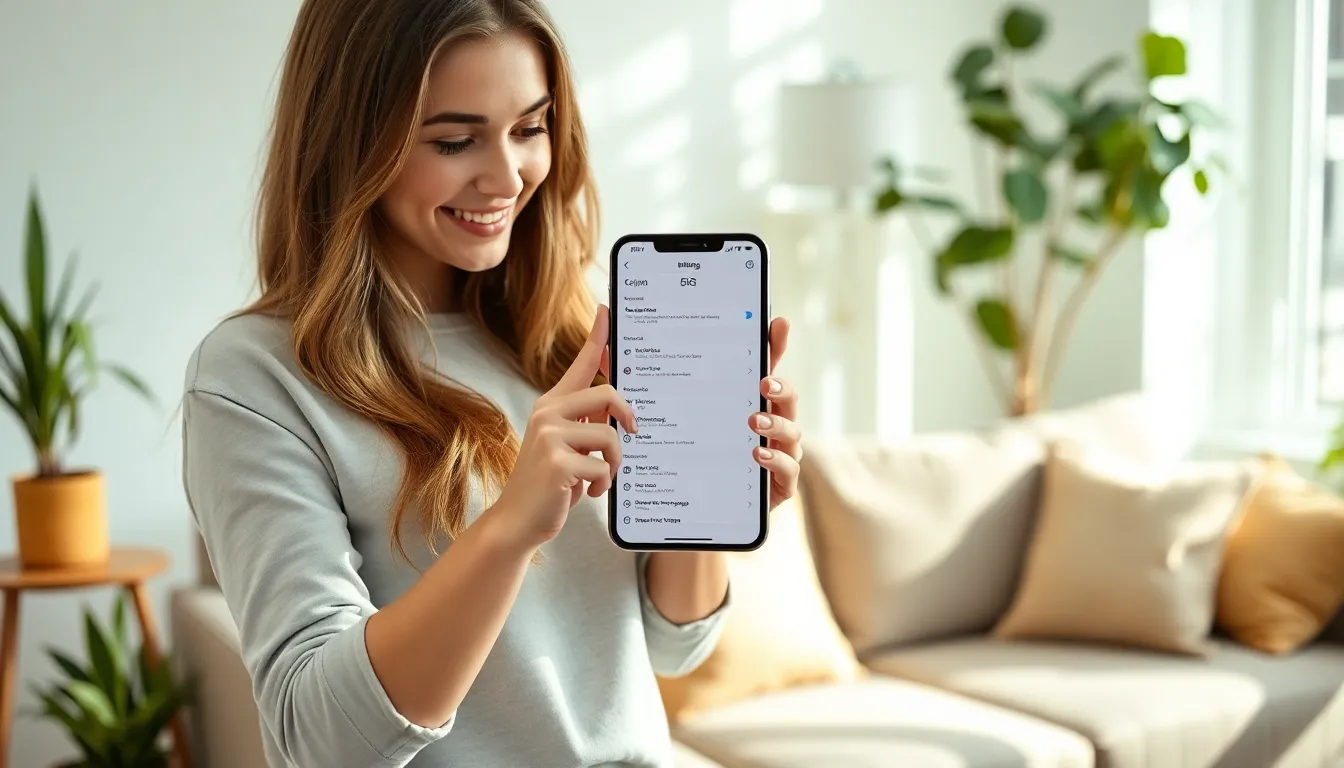In a world where speed is king, waiting for a webpage to load feels like watching paint dry. Enter 5G: the superhero of mobile connectivity that promises lightning-fast downloads and seamless streaming. But what if your iPhone is still stuck in the slow lane? Fear not! Getting 5G on your device is easier than finding a cat video on the internet.
Table of Contents
ToggleUnderstanding 5G Technology
5G technology represents the fifth generation of mobile networks. This advancement enhances mobile connectivity significantly, making it crucial for modern communication.
What Is 5G?
5G stands for fifth generation. It delivers faster download and upload speeds compared to its predecessors. Enhanced connectivity facilitates lower latency, improving real-time interaction during streaming or gaming. This technology also supports a greater number of devices simultaneously, addressing the increasing demand for mobile internet access.
Benefits of 5G Connectivity
5G offers multiple benefits that enhance user experience. Faster speeds enable quick downloads and seamless streaming, supporting high-definition content. Low latency enhances the performance of applications requiring real-time responsiveness, like online gaming or video conferencing. Improved network reliability ensures a more stable connection, minimizing interruptions during usage. Greater device capacity means more users can connect without experiencing slowdowns, accommodating smart city initiatives and the Internet of Things (IoT).
Device Compatibility

5G technology enhances mobile connectivity, but not all iPhones support it. Understanding your device’s compatibility is crucial for accessing 5G networks efficiently.
Supported iPhone Models
Certain iPhone models support 5G connectivity. The iPhone 12 series, including the iPhone 12, iPhone 12 Mini, iPhone 12 Pro, and iPhone 12 Pro Max, officially introduced 5G capabilities. Following this, the iPhone 13 series, iPhone 14 series, and the latest iPhone models also feature 5G support. Users with older models like the iPhone 11 or earlier will not experience 5G functionalities.
How to Check Your iPhone’s 5G Status
Checking the 5G status on an iPhone is simple. First, open the Settings app, then select Cellular. Tap on Cellular Data Options, where you’ll find the Voice & Data section. If your device supports 5G, you’ll see options for 5G On, 5G Auto, and LTE. Confirming that 5G is enabled allows access to enhanced speeds and improved performance, perfect for streaming and downloading content seamlessly.
Setting Up 5G on Your iPhone
Setting up 5G on an iPhone enhances mobile connectivity for users. It involves a few straightforward steps, ensuring access to faster speeds and improved performance.
Enabling 5G in Settings
To enable 5G, open the Settings app. Tap on Cellular, then select Cellular Data Options. From there, tap on Voice & Data. You’ll see options for 5G On, 5G Auto, and LTE. Choosing 5G On allows constant access to 5G networks, while 5G Auto enables automatic selection based on coverage and availability. This feature helps maintain battery efficiency while optimizing connectivity.
Selecting a 5G Plan with Your Carrier
Choosing the right 5G plan involves checking with your carrier. Providers offer various plans that may differ in data limits and pricing. Verifying compatibility with 5G is essential. Many carriers provide options specifically designed for 5G users, ensuring the best performance. Frequently, plans offering unlimited data can enhance the usage experience, particularly for heavy streaming and gaming. It’s crucial to review the terms of each plan for potential promotions or limited-time offers.
Troubleshooting 5G Issues
Issues with 5G connectivity can frustrate users. Identifying common problems can lead to quick fixes.
Common Problems with 5G Connectivity
Weak signal strength is a frequent issue affecting many users. Areas with limited 5G coverage can result in slow speeds or connectivity drops. Compatibility problems may arise if the device is not updated or not on a supported network. Additionally, settings might restrict access to 5G, especially if the wrong option is selected under Cellular Data Options. Network congestion can occur in highly populated areas, leading to buffering or interrupted connections.
Tips for Resolving 5G Issues
Resetting network settings can help resolve connectivity problems. Turning on Airplane Mode for a few seconds may restore 5G signals. Checking for software updates ensures the iPhone runs on the latest version, which enhances performance and stability. Contacting the carrier for troubleshooting assistance can clarify any network-related issues. Lastly, experimenting with different locations allows users to find stronger signals and may improve overall connectivity.
Embracing 5G technology on an iPhone opens up a world of possibilities for users seeking faster connectivity and improved performance. With a few simple steps in the Settings app, anyone can activate 5G and enjoy the benefits it brings.
Understanding device compatibility is crucial for maximizing this technology’s potential. By selecting the right plan and troubleshooting common connectivity issues, users can ensure a seamless experience.
As mobile internet demands continue to rise, leveraging 5G will be essential for staying connected in today’s fast-paced environment.




